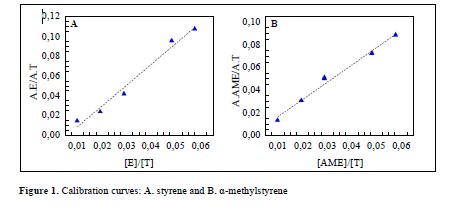Resumen
Estireno y α-metilestireno son sustratos de gran interés en catálisis asimétrica. Aunque han sido ampliamente usados, las metodologías de cuantificación conocidas se restringen al uso de detectores de espectrometría de masas y no se encuentran validadas. En el presente trabajo se desarrolló y validó un método confiable mediante cromatografía de gases con detector de ionización de llama (GCFID) para el análisis de olefinas no funcionalizadas (estireno y α-metilestireno) en matrices líquidas utilizando el tolueno como patrón interno. Los parámetros de validación evaluados incluyeron selectividad, linealidad, límite de detección, límite de cuantificación, precisión y exactitud. El análisis evidenció una separación adecuada de cada analito de interés bajo las condiciones y el rango de trabajo implementado (6,83x10-4 mol/L – 4,059x10-3 mol/L). Los parámetros evaluados registraron valores dentro de los rangos de aceptación, lo que confirmó que el método validado es selectivo, lineal, preciso y exacto. Este trabajo representa un esfuerzo por desarrollar un método cromatográfico validado seguro y eficiente para la cuantificación de estireno y α-metilestireno en matrices líquidas, y su posible aplicación en el campo de las resinas, plastificantes y polímeros.
Referencias
Aguirre-Ortega, L., Pérez-Cuadrado, J., Pujol-Forn, M. (2001). Validación de métodos analíticos. Barcelona, España: Asociación Española de Farmacéuticos de la Industria. p. 46.
Association of Official Agricultural Chemists - AOAC. (2013). Appendix K: Guidelines for Dietary Supplements and Botanicals. Accessed on September 28, 2019. Avalaible at: http://www.eoma.aoac.org/app_k.pdf
Berijani, K., Morsali, A., Hupp, J. T. (2019). An effective strategy for creating asymmetric MOFs for chirality induction: a chiral Zr-based MOF for enantioselective epoxidation. Catalysis Science & Technology. 9 (13): 3388-3397.
Bubeníková, T., Bednár, M., Gergeľ, T., Igaz, R. (2019). Adsorption Effect of Added Powder Graphite on Reduction of Volatile Organic Compounds Emissions from Expanded Polystyrene. BioResources. 14 (4): 9729-9738.
Coelho, M. & Ribeiro, B. (2016). White biotechnology for sustainable chemistry (p. 249). Cambridge: Royal Society of Chemistry.
Even, M., Hutzler, C., Wilke, O., Luch, A. (2019). Emissions of volatile organic compounds from polymer‐based consumer products: comparison of three emission chamber sizes. Indoor Air. 30 (1): 40-48.
Food and Drug Administration - FDA. (2018). Bioanalytical Method Validation Guidance for Industry. Accessed on September 28, 2019. Avaliable at: https://www.fda.gov/media/70858/download
Gabhe, S. (2015). Development And Validation Of Chromatographic Methods For Simultaneous Quantification Of Drugs In Bulk And In Their Formulations: HPLC And HPTLC Techniques (p. 22-25).Hamburg, Germany: Anchor Academic Publishing.
Gennari, O., Albrizio, S., Monteiro, M. (2012). A GC–FID method to determine styrene in polystyrene glasses. Food Analytical Methods. 5 (6): 1411-1418.
Gomes, D., de Pinho, P., Pontes, H., Ferreira, L., Branco, P., Remião, F., et al. (2010). Gas chromatography–ion trap mass spectrometry method for the simultaneous measurement of MDMA (ecstasy) and its metabolites, MDA, HMA, and HMMA in plasma and urine. Journal Of Chromatography B. 878 (9-10): 815-822.
Hadian-Dehkordi, L. & Hosseini-Monfared, H. (2016). Enantioselective aerobic oxidation of olefins by magnetite nanoparticles at room temperature: a chiral carboxylic acid strategy. Green Chemistry. 18 (2): 497-507.
Huang, J., Liu, S., Ma, Y., Cai, J. (2019). Chiral salen Mn (III) immobilized on ZnPS-PVPA through alkoxyl-triazole for superior performance catalyst in asymmetric epoxidation of unfunctionalized olefins. Journal Of Organometallic Chemistry. 886: 27-33.
Hwang, J. B., Lee, S., Yeum, J., Kim, M., Choi, J. C., Park, S.-J., Kim, J. (2019). HS-GC/MS method development and exposure assessment of volatile organic compounds from food packaging into food simulants. Food Additives & Contaminants: Part A. 36 (10): 1574-1583.
International Council for Harmonisation of Technical Requirements for Pharmaceuticals for Human Use - ICH. (2005). Validation of analytical procedures: text and methodology Q2 (R1). Paper presented at the International conference on harmonization, Geneva, Switzerland.
Poole, C. (2012). Gas chromatography (1st ed., pp. 435-448). Amsterdam, Netherland: Elsevier.
Nageswara-Rao, T. (2018). Validation of Analytical Methods. En M.Stauffer (Ed.). Calibration and Validation of Analytical Methods: A Sampling of Current Approaches (pp. 131-141). London, United Kingdom: BoD–Books on Demand.
Tang, X., Tang, Y., Xu, G., Wei, S., Sun, Y. (2008). Highly enantioselective epoxidation of styrene and α-methylstyrene catalyzed by new doubly-immobilized chiral (salen) Mn(III) catalysts. Catalysis Communications. 10 (3): 317-320.
United Nations Office on Drugs and Crime - UNODC. (2009). Guidance for the Validation of Analytical Methodology and Calibration of Equipment used for Testing of Illicit Drugs in Seized Materials and Biological Specimens. Accessed on September 27, 2019. Avaliable at: https://www.unodc.org/documents/scientific/validation_E.pdf
Wong, O. & Shi, Y. (2008). Organocatalytic Oxidation. Asymmetric Epoxidation of Olefins Catalyzed by Chiral Ketones and Iminium Salts. Chemical Reviews. 108 (9): 3958-3987.
Xia, Q., Ge, H., Ye, C., Liu, Z., Su, K. (2005). Advances in Homogeneous and Heterogeneous Catalytic Asymmetric Epoxidation. Chemical Reviews. 105 (5): 1603-1662.
Zuas, O., Mulyana, M. R., Budiman, H. (2016). Analytical method validation of GC-FID for the simultaneous measurement of hydrocarbons (C2-C4) in their gas mixture. Revista Colombiana de Química. 45 (3): 22-27.

Esta obra está bajo una licencia internacional Creative Commons Atribución-NoComercial-SinDerivadas 4.0.
Derechos de autor 2020 Revista de la Academia Colombiana de Ciencias Exactas, Físicas y Naturales

